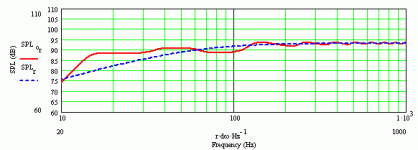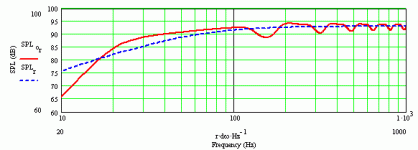Hi :
I have an old Philips 12” woofer ( AD 12100/W8 ).
Its T&S parameters are :
Vas = 0.422 m3
Fs = 19 hz
Qts = 0.27
I make a small TQWT calculator (XLS sheet).
http://geocities.com/dbr_audio/Voigt_calculator.ZIP
This BIB is OK?
http://geocities.com/dbr_audio/BIB_AD12100.pdf
Best regards
Jaime
I have an old Philips 12” woofer ( AD 12100/W8 ).
Its T&S parameters are :
Vas = 0.422 m3
Fs = 19 hz
Qts = 0.27
I make a small TQWT calculator (XLS sheet).
http://geocities.com/dbr_audio/Voigt_calculator.ZIP
This BIB is OK?
http://geocities.com/dbr_audio/BIB_AD12100.pdf
Best regards
Jaime
My language skills are about 0, but one thing I will suggest is beware of assuming that you can just take a tuning frequency and divide by 4 to get a length. That's fine for straight pipes, but tapered ones will need a different length.
See two of Martin King's articles on the subject: http://www.quarter-wave.com/Theory/TL_Anatomy.pdf
And http://www.quarter-wave.com/Theory/Alignment_Tables.pdf for more.
Technically what you have there is not a BIB, since the BIB's length is set to 1/2, not 1/4 wavelength of the tuning frequency, it's an So=0 pipe to get maximum gain across the broadest frequency range, and the driver is placed at a specific accoustic length to minimise ripple in FR applications. That's not to say this won't work, but it's not a BIB! Do you have any more detailed parameters and I'll run a MathCad sim for you.
Best
Scott
See two of Martin King's articles on the subject: http://www.quarter-wave.com/Theory/TL_Anatomy.pdf
And http://www.quarter-wave.com/Theory/Alignment_Tables.pdf for more.
Technically what you have there is not a BIB, since the BIB's length is set to 1/2, not 1/4 wavelength of the tuning frequency, it's an So=0 pipe to get maximum gain across the broadest frequency range, and the driver is placed at a specific accoustic length to minimise ripple in FR applications. That's not to say this won't work, but it's not a BIB! Do you have any more detailed parameters and I'll run a MathCad sim for you.
Best
Scott
Scott:
Philips AD 12100/W8
Nominal diameter : 12”
The parameters are:
Fs : 19 hz
Vas : 422 lts
Qms : 5.10
Qes : 0.29
Qts : 0.27
Re : 6.5 ohms
Sensitivity : 93 dB/1w*1m
Power handling : 60w
Sd : 511 cm2
Xmax : 5mm (aprox)
I have FE108EZ rear-horns. The sound is nice but I wants more bass. I am thinking an active sub 100 hz amplifier.
Best regards
Jaime
Philips AD 12100/W8
Nominal diameter : 12”
The parameters are:
Fs : 19 hz
Vas : 422 lts
Qms : 5.10
Qes : 0.29
Qts : 0.27
Re : 6.5 ohms
Sensitivity : 93 dB/1w*1m
Power handling : 60w
Sd : 511 cm2
Xmax : 5mm (aprox)
I have FE108EZ rear-horns. The sound is nice but I wants more bass. I am thinking an active sub 100 hz amplifier.
Best regards
Jaime
OK. It's possible to do an expanding line for these cabinets, but that wouldn't be my first choice (I'll explain why in a minute).
However, if you really want an expanding line, we'll look at that initially. Using Martin King's alignment tables, we see that we need a considerably longer line length: 221.5in to be exact using a 1:5 taper ratio (not quite the same as yours, but you get the idea, and we'll stick with this for the moment as an example) to get the correct level of reinforcement.
Using this, and increasing cabinet volume somewhat, we can get a response similar to that shown below. Providing you cross over to the 108 horns before you reach the null at ~73Hz, you should be fine. These use the length I mentioned above, are 12in wide internally, the sealed end 4in deep, the open end 20in deep, Zdriver at 78.75in and 0.25lbs ft^3 of stuffing in the first half of the line.
However, if you really want an expanding line, we'll look at that initially. Using Martin King's alignment tables, we see that we need a considerably longer line length: 221.5in to be exact using a 1:5 taper ratio (not quite the same as yours, but you get the idea, and we'll stick with this for the moment as an example) to get the correct level of reinforcement.
Using this, and increasing cabinet volume somewhat, we can get a response similar to that shown below. Providing you cross over to the 108 horns before you reach the null at ~73Hz, you should be fine. These use the length I mentioned above, are 12in wide internally, the sealed end 4in deep, the open end 20in deep, Zdriver at 78.75in and 0.25lbs ft^3 of stuffing in the first half of the line.
Attachments
We can do a mass-loaded version of the above. Same cabinet, Zdriver shifted to 110in from the sealed end, with a 4in diameter, 0.75in long port at the end of the line.
Both go low, and won't need much power at all. However, I still wouldn't build either of them -these are very large cabinets indeed -too large to be practical. We can tune higher to reduce the size (well, the height, though we'd need to increase footprint to regain some Vb -see why I don't think an expanding line is a good idea in this case? ;-) but there's a much better way.
Both go low, and won't need much power at all. However, I still wouldn't build either of them -these are very large cabinets indeed -too large to be practical. We can tune higher to reduce the size (well, the height, though we'd need to increase footprint to regain some Vb -see why I don't think an expanding line is a good idea in this case? ;-) but there's a much better way.
Attachments
The best way is to throw the expanding line idea out of the window and go for a classic, wide at sealed end, narrow at open end TL.
The advantage of the negative taper line is that it can be considerably shorter than an expanding or a straight line. In this case, believe it or not, using a 3:1 taper ratio, we're looking at a 120in line length. Zdriver is 40.5in. 3:1 taper ratio, So=240in^2 CSA, Sl=80in^2 CSA. 0.25lbs ft^3 of stuffing in the first 2/3 of the line.
The response slowly decreases below 100Hz, pretty much in lock-step with room-gain. I've designed a few of these before and all the builders report excellent results, though most suspect they need stronger foundations... ;-) Much more manageable cabinet this too -only about 60in tall.
BTW -if you're wondering about some of the abbreviations:
CSA = Cross Sectional Area.
So = Area of sealed end
Sl = Area of open end
Zdriver = distance of driver centre from the internal top of the line.
My apologies for using the Imperial, not the metric system, but it's what I'm more comfortable with.
Hope some of this is useful
Best
Scott
The advantage of the negative taper line is that it can be considerably shorter than an expanding or a straight line. In this case, believe it or not, using a 3:1 taper ratio, we're looking at a 120in line length. Zdriver is 40.5in. 3:1 taper ratio, So=240in^2 CSA, Sl=80in^2 CSA. 0.25lbs ft^3 of stuffing in the first 2/3 of the line.
The response slowly decreases below 100Hz, pretty much in lock-step with room-gain. I've designed a few of these before and all the builders report excellent results, though most suspect they need stronger foundations... ;-) Much more manageable cabinet this too -only about 60in tall.
BTW -if you're wondering about some of the abbreviations:
CSA = Cross Sectional Area.
So = Area of sealed end
Sl = Area of open end
Zdriver = distance of driver centre from the internal top of the line.
My apologies for using the Imperial, not the metric system, but it's what I'm more comfortable with.
Hope some of this is useful
Best
Scott
Attachments
Hi Scott:
Your have made a good work !!!.
Now I will have to think and draw.
Non problem with the Imperial system.
Thank you very much. I will write to you soon
Best regards
Jaime
Your have made a good work !!!.
Now I will have to think and draw.
Non problem with the Imperial system.
Thank you very much. I will write to you soon
Best regards
Jaime
Scott:
I draw the two suggested boxes.
The Expanding Line is very large but the response under 70 Hz is very good.
The Negative Taper Line is compact and attractive and probably will be easy to match with the FE108EZ.
This in not an easy decision.
Best regards Jaime
I draw the two suggested boxes.
The Expanding Line is very large but the response under 70 Hz is very good.
The Negative Taper Line is compact and attractive and probably will be easy to match with the FE108EZ.
This in not an easy decision.
Best regards Jaime
Attachments
I'd go for the negative taper line -it'll work better in-room as the response decreases in proportion with room-gain so it should be flat. The expanding line will probably need some additional damping near the mouth damping if it isn't to boom, though venting upward should help reduce that. I think I can safely say that either will sound like an earthquke has struck your house when they are called to. ;-)
Best
Scott
Best
Scott
- Status
- Not open for further replies.
- Home
- Loudspeakers
- Full Range
- This BIB is OK?


